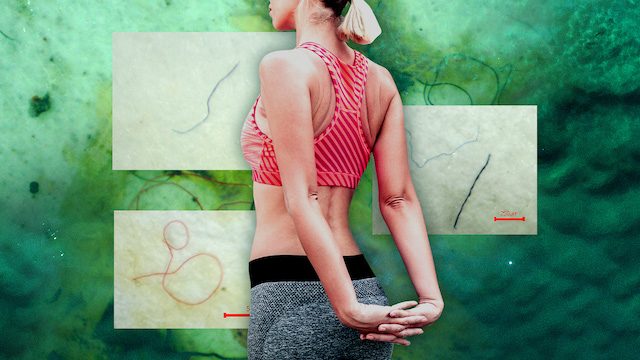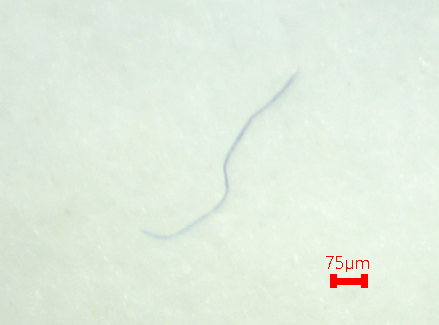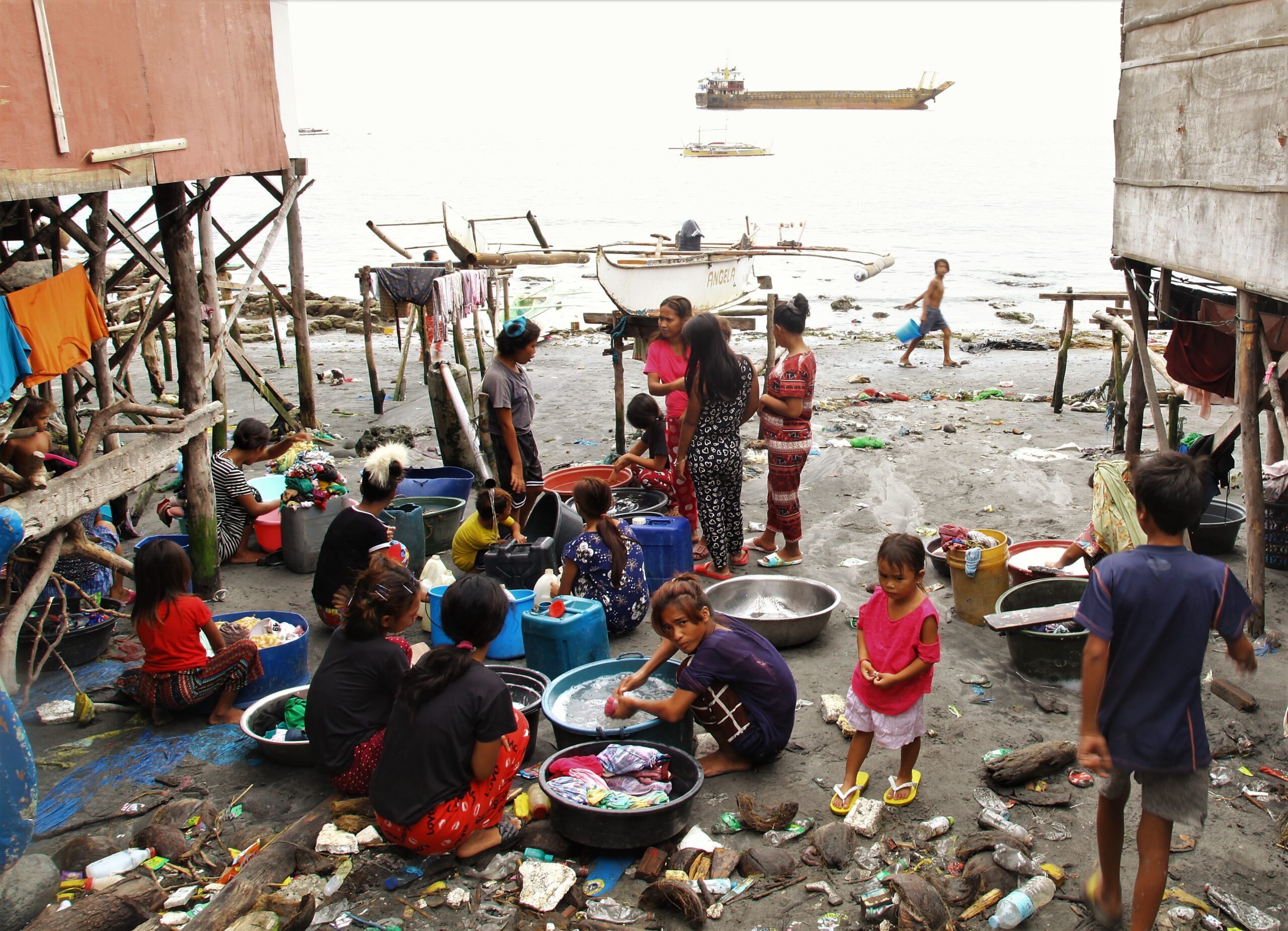SUMMARY
This is AI generated summarization, which may have errors. For context, always refer to the full article.

MANILA, Philippines – It’s almost like you can’t be stylish without that sporty element in your outfit.
Nowadays, people don’t just wear a sports bra or yoga pants to the gym. They are just as appropriate for a movie date, a trip to the grocery, a hangout with friends.
But the athleisure trend that has been a mainstay in wardrobes for years now is exacerbating microplastic pollution. In the Philippines, already one of the world’s biggest plastic polluters, this is compounded by gaps in sewerage systems and the popularity of cheap “fast fashion.”
This is because most clothes, and activewear in particular, tend to be made of plastic fabrics. These fabrics – like nylon, acrylic, polyester, and polyamide – shed tiny plastic fibers called microfibers when they are manufactured, worn, and washed.
Recent studies by Filipino scientists show microfibers have made their way to our rivers and seas.
These tiny plastic fibers have been found in mussels in Cavite and the fecal matter of whale sharks in Cebu. As they accumulate in natural environments, they get deep into the food chain and end up inside animals and humans. Even worse, microplastics tend to attract toxins so that when we ingest the microplastics, we can ingest toxic chemicals too.
A 2021 study by University of the Philippines environmental engineering students found microplastic lines and fibers in six tributaries to Manila Bay. These were mainly polypropylene (PP) and polyethylene (PE) lines and fibers, which may have come from straws, fishing ropes and nets, or clothing.
The study is the first microplastics study in Manila Bay. The students analyzed water samples from the mouths of rivers leading to Manila Bay: the Cañas, Meycauayan, Parañaque, Pasig, and Tullahan rivers.

Environmental engineer Ezra Osorio, co-author of the 2021 study, conducted an even more recent study of wastewater from a sewage treatment plant in Metro Manila. Most of the microplastics they found in the dirty water entering the plant were fibers.
“Around 80% were filaments or fibers…. We identified nylon and polypropylene. We assume that it is from clothing and face masks,” he told Rappler.
Polypropylene, in fiber form, typically comes from clothing. Because of its durability and moisture-wicking properties, polypropylene is commonly used for underwear and activewear.
The wastewater analyzed came from households nearby. Microfibers in our water systems likely come from clothes being laundered.
“Washing is the main source of microfibers. Most of those doing laundry in densely populated areas, they just wash outside their homes, then their drainage is not connected to a sewage treatment plant, so it will just go to the nearest canal, which leads to the tributaries,” said Osorio.
Philippine studies echo findings of studies done abroad. A report on the impact of fashion on the environment by the Ellen MacArthur Foundation said microfibers have become a “major contributor” to microplastics pollution. It cited a 2011 University of California study where microfibers found in beaches were from synthetic fabrics like acrylic and nylon often used for clothing.




George Leonard, chief scientist for the Ocean Conservancy, estimates there could be 1.4 quadrillion microfibers floating in the world’s oceans.
In China, a 2021 study found a higher concentration of microplastics in rivers within textile manufacturing zones. China is a major producer of synthetic fabrics used for fast fashion and activewear.
Wastewater from the textile manufacturing facilities were said to be the reason why polyethylene terephthalate (PET) microfibers accounted for most of the microplastics found in the river water.
A love affair with plastic
Synthetic fabrics derived from plastic – like acrylic, nylon, and polyester – are often used for activewear because of their durability, sweat-wicking, anti-wrinkle, stretchy, or water-resistant features.
Anyone with an active or outdoorsy lifestyle would recognize why these characteristics are a plus in clothing. They help keep one dry during that morning run in the rain. They guard against embarrassing sweat marks at the gym. The stretchiness helps one pull off that tricky workout move.
But while in the past, most people would have only a few pieces of activewear in their wardrobes, today, such clothes are taking up a bigger part of the closet, all thanks to the athleisure trend.


The athleisure industry kept growing even amid the COVID-19 pandemic. Lockdowns even spurred athleisure sales in the Philippines, according to a 2022 report by market research firm Euromonitor International.
“Home seclusion and the increased number of consumers working from home supported demand for athleisure products in the previous year,” read the report.
“As consumers around the archipelago switched to working from home and stayed at home as much as possible, sports-inspired apparel performed better than all other product areas in sportswear due to the fact that consumers still sought comfortable clothing that is suitable to wear around the house,” it read.
The consequence of higher usage is more frequent washing – and more microfibers entering waterways and, eventually, natural environments.
Scientists at the University of Plymouth did a 2016 study on how much microfibers were shed after machine-washing clothes made of different types of fabric. The plastic clothes – an acrylic sweater and polyester hoodie – released the most microfibers, 700,000 and 500,000 fibers, respectively. A polyester-cotton blend T-shirt shed less – around 130,000 fibers.
Some 60% of clothes purchased worldwide are made of plastic fibers, according to a 2013 report by the United Nations’ Food and Agriculture Organization and the International Cotton Advisory Committee.
Philippines’ weakness: Gaps in sewerage system coverage
One big step to stopping most microfiber pollution can be found in our laws. The tragedy is the law’s lack of implementation.
The Philippine Clean Water Act (Republic Act No. 9275) states that all subdivisions, condominiums, commercial buildings, hospitals, industrial complexes, and other establishments are supposed to be connected to a sewerage system that would have wastewater treatment facilities.
In Metro Manila, at least, this job falls on the Metropolitan Waterworks and Sewerage System (MWSS), Maynilad, Manila Water, and local governments.
Wastewater treatment can prevent 88% of microplastics in wastewater from escaping into rivers and tributaries, according to a 2020 study published in the Royal Science of Chemistry journal.
The figure echoed the findings of Osorio’s team when it analyzed wastewater in a Metro Manila sewage treatment plant. The treatment process was able to remove 80% of microplastics from the water.

But as John Paul Jucar, a wastewater treatment expert, said, many homes and establishments aren’t covered by such sewerage systems.
Jucar is the chief operating officer of Fluid Technologies and Environmental Management Inc., a private water and wastewater management company.
“A huge chunk of wastewater generators are still not being catered to because of lack of coordination or agreement between concessionaires and local government units to maximize the reach of the centralized treatment facilities,” he told Rappler.
And like in many other Asian countries, washing clothes in rivers or near water bodies is a common sight, especially in poor urban and rural communities. Some households simply don’t mind that they aren’t connected to any sewerage system.
Poor urban planning and huge costs of setting up such systems have contributed to the problem.
But even when sewerage systems cover more establishments, there’s still a way for microplastics to escape. The microplastics collected by these treatment plants end up in biological sludges that, in some cases, are thrown in landfills or buried in the soil.
Then there’s the 20% of microplastics that still evade treatment plants and flow into rivers, lakes, and seas.
That’s why experts say the best solution is to change the problematic products themselves.
The New Textiles Economy report by the Ellen MacArthur Foundation called for clothing companies to move away from synthetic fabrics and use fabrics made of natural fibers or fibers that can biodegrade.
Natural fibers like cotton take their own toll on the environment by requiring vast amounts of water. There is also a movement within these industries to make their processes more efficient and less resource-intensive. Natural fibers that use up less water include linen and hemp.
Big activewear companies like Patagonia seem to be taking the problem seriously, pouring funds into microplastics research, alternative fabrics, and material that don’t shed as much microfibers when washed.
There are new fabrics like Tencel that are light and versatile but derived from plants, thus biodegradable.
What you can do
Part of the solution lies with the people who wear the clothes.
“What consumers can do is really using what you have in your wardrobe. Either you reuse them, or you restyle them, or think about how you can wear these clothes differently,” said Marian Ledesma, a zero-waste campaigner for Greenpeace.
Above all, people should avoid “fast fashion” or clothes made in large quantities but with low quality because of an industry priority to produce more and at a faster pace, she said.
Having a “capsule wardrobe” made of only a few good-quality pieces that can be used for long periods of time is much more sustainable. Even better if the clothes are made of natural fibers.
But clothes made of organic natural fibers can be expensive. Shirts or short dresses made entirely of cotton could go for under P1,000 in stores like Uniqlo or for thousands of pesos in more high-end brands using special cotton. Linen clothes are usually a bit pricier with tops, dresses, and pants often in the thousands. In comparison, synthetic clothes can be as cheap as less than a hundred pesos for a shirt or under a thousand pesos for pants and dresses.
Other affordable options could be to just buy secondhand clothes. This is where another popular Filipino consumer habit can help.
“If you have to buy clothes, look into buying secondhand clothing. We have a lot of ukay-ukay (thrift shops) in the Philippines,” said Ledesma.
And even if one must shell out more money for durable, natural-fiber clothes, not having to buy another one for a long time could still be a cost-saving measure.
“You have to look at cost-benefit analysis. If you invest money in more durable options in clothing that last longer, you will buy less of these problematic clothing, you can still make savings in the end,” said Ledesma.
The more consumers adopt a slow-fashion approach and reject fast fashion, Ledesma is hopeful that apparel makers will listen and revamp their product lines to make natural-fabric clothing more affordable.
And if synthetic activewear can’t be totally eliminated from your closet, there’s an even simpler step you can take: wash your clothes less.
If you’re doing a workout at home or for a short period of time, you can just air out your sports bra and other athletic wear instead of throwing them into the laundry basket every time, said Ledesma.
The idea of postponing a wash is not new. In fact, in the case of denim jeans, Levi’s CEO Chris Burgh has even said they should never be washed.
But for those squeamish about reusing clothes in between washes, there are already innovations that keep microfibers from leaving the washing machine.
Bags by Guppy Friend separate activewear and synthetic clothes from the rest of your laundry and keep the microfibers from washing down the pipes. Microplastic filters you can install in your washing machine are also available online. There are microplastic catcher balls that absorb the microfibers from your clothes as they tumble around in the washing machine.
Clothing is far from the only source of microplastics or even, specifically, microfibers. They can come from virtually all types of plastic objects – like bottle caps, pails, fishermen’s nets and ropes, bags, and straws.
All industries dependent on plastic – not just the clothing or textile industries – have to rethink their products and packaging to curb microplastic pollution. – Rappler.com
Add a comment
How does this make you feel?





There are no comments yet. Add your comment to start the conversation.